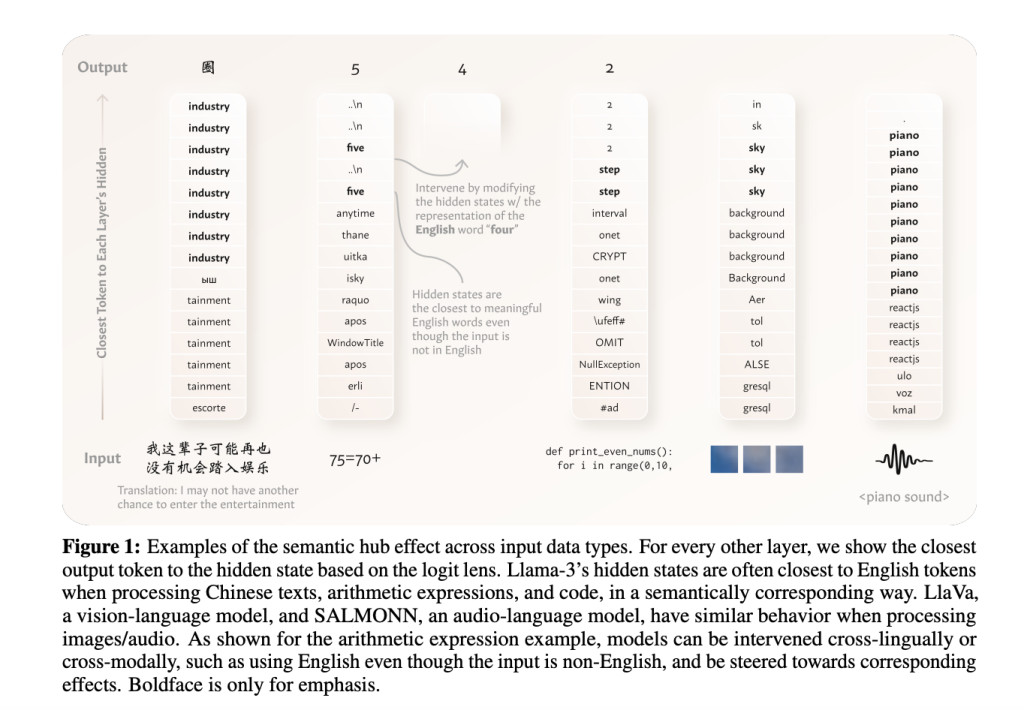

Language models have demonstrated remarkable capabilities in processing diverse data types, including multilingual text, code, mathematical expressions, images, and audio. However, a fundamental question arises: how do these models effectively handle such heterogeneous inputs using a single parameter set? While one approach suggests developing specialized subspaces for each data type, this overlooks the inherent semantic connections that exist across seemingly different forms of data. For instance, equivalent sentences in different languages, image-caption pairs, or code snippets with natural language descriptions all share conceptual similarities. Much like the human brain’s transmodal semantic hub that integrates information from various sensory inputs, there exists an opportunity to develop models that can project different data types into a unified representation space, perform computations, and generate appropriate outputs. The challenge lies in creating an architecture that can effectively utilize these structural commonalities while maintaining the unique characteristics of each data type.
Previous attempts to address cross-data-type representation have primarily focused on aligning separately trained mono-data-type models through transformation techniques. Research has demonstrated success in aligning word embeddings across different languages through mapping methods, and similar approaches have been applied to connect visual and textual representations from distinct models. Some studies have explored minimal fine-tuning of language-only models to handle multimodal tasks. Additional research has investigated representation evolution through transformer layers, examining its impact on reasoning, factuality, and knowledge processing. Layer pruning and early exiting studies have also provided insights into representation dynamics. However, these approaches typically require separate models or transformations between representations, limiting their efficiency and potentially missing deeper connections between different data types. Also, the need for explicit alignment mechanisms adds complexity and computational overhead to the systems.
Researchers from MIT, the University of Southern California, and the Allen Institute for AI propose a robust approach to understanding how language models process multiple data types through a shared representation space. The methodology centers on investigating the existence of a “semantic hub†– a unified representation space scaffolded by the model’s dominant data type, typically English. This approach examines three key aspects: first, analyzing how semantically similar inputs from different data types (languages, arithmetic expressions, code, and multimodal inputs) cluster together in intermediate model layers; second, investigating how these hidden representations can be interpreted through the model’s dominant language using the logit lens technique; and third, conducting intervention experiments to demonstrate that this shared representation space actively influences model behavior rather than being a passive byproduct of training. Unlike previous approaches focusing on aligning separately trained models, this methodology examines how a single model naturally develops and utilizes a unified representation space without requiring explicit alignment mechanisms.
The semantic hub hypothesis testing framework employs a sophisticated mathematical architecture built on domain-specific functions and representation spaces. For any data type z in the model’s supported set Z, the framework defines a domain Xz (such as Chinese tokens for language or RGB values for images) and two crucial functions: Mz, which maps input sequences into a semantic representation space Sz, and Vz, which transforms these representations back into the original data type format. The testing methodology evaluates two fundamental equations: first, comparing the similarity between semantically related inputs from different data types using cosine similarity measures of hidden states, and second, examining the relationship between these representations and the model’s dominant language through the logit lens technique. This technique analyzes hidden states at intermediate layers by applying the output token embedding matrix, producing probability distributions that reveal the model’s internal processing. The architecture has been rigorously tested across multiple data types, including various languages, arithmetic expressions, code, semantic structures, and multimodal inputs, consistently demonstrating the existence of a unified semantic representation space.
The research presents compelling results from intervention experiments that validate the causal impact of the semantic hub on model behavior. In multilingual experiments using the Activation Addition technique, interventions in the English representation space effectively steered model outputs even when processing Spanish and Chinese texts. Testing on 1000 prefixes from both the InterTASS dataset (Spanish) and the multilingual Amazon reviews corpus (Chinese), the study compared model outputs with and without interventions using language-specific sentiment trigger words (Good/Bad, Bueno/Malo, 好/å). These experiments demonstrated that English-based interventions achieved sentiment steering effects comparable to interventions using the text’s native language while maintaining generation fluency and relevance. The researchers evaluated the quality of generated text using three key metrics: sentiment alignment with the intended direction, fluency of the generated text, and relevance to the original prefix. The results strongly support the hypothesis that the semantic hub is not merely a byproduct of training but actively influences the model’s cross-lingual processing capabilities.
The research advances the understanding of how language models process diverse data types through a unified semantic hub. The study conclusively demonstrates that models naturally develop a shared representation space where semantically related inputs cluster together, regardless of their original modality. This discovery, validated across multiple models and data types, opens new possibilities for model interpretation and control through targeted interventions in the dominant language space.
Check out the Paper. All credit for this research goes to the researchers of this project. Also, don’t forget to follow us on Twitter and join our Telegram Channel and LinkedIn Group. If you like our work, you will love our newsletter.. Don’t Forget to join our 55k+ ML SubReddit.
[AI Magazine/Report] Read Our Latest Report on ‘SMALL LANGUAGE MODELS‘
The post The Semantic Hub: A Cognitive Approach to Language Model Representations appeared first on MarkTechPost.
Source: Read MoreÂ



